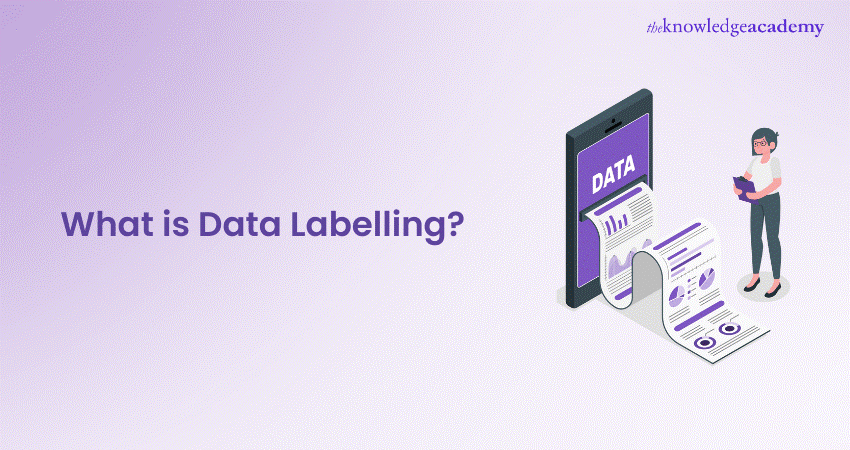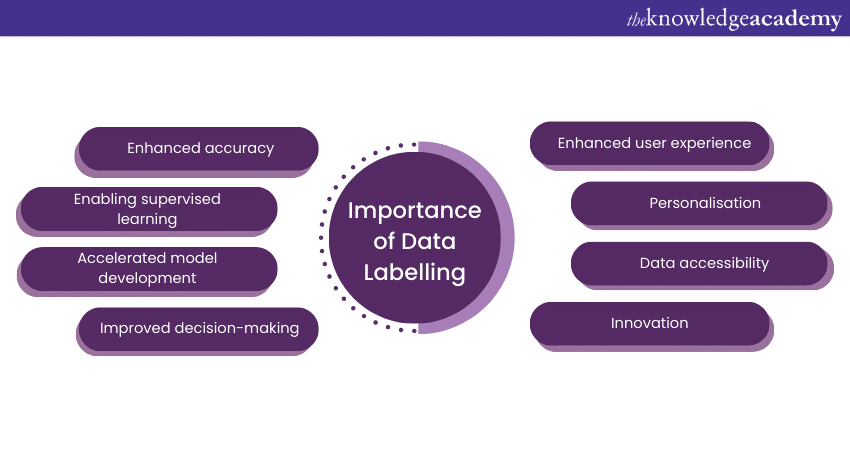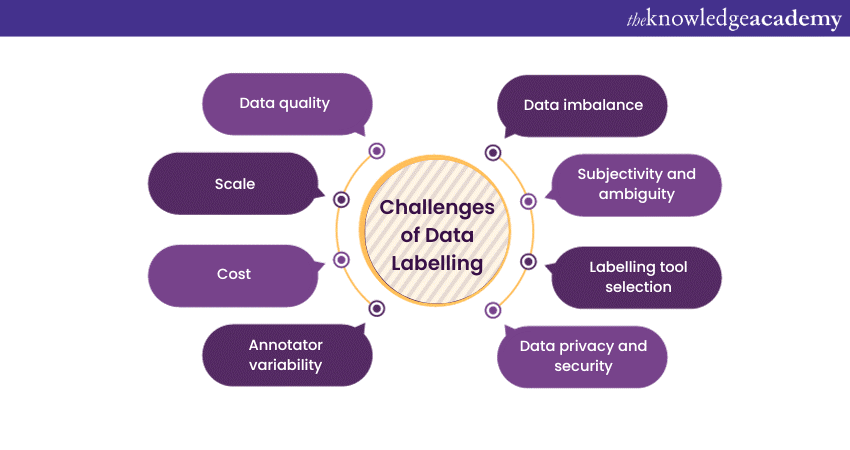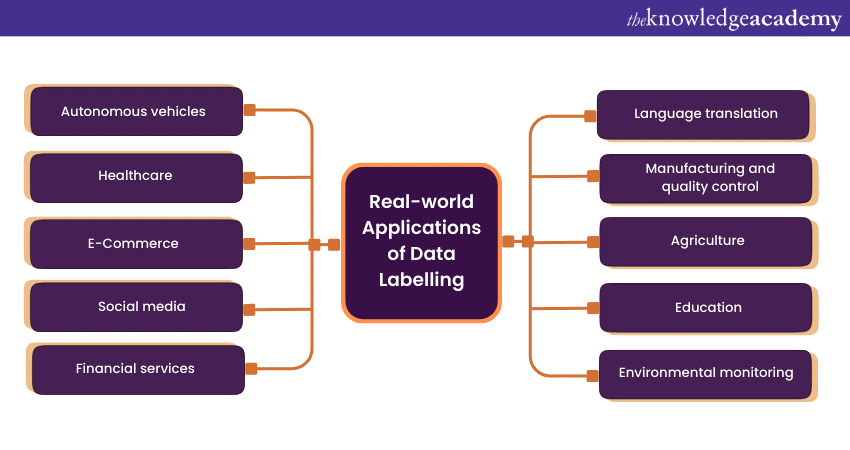We may not have the course you’re looking for. If you enquire or give us a call on +31 208081674 and speak to our training experts, we may still be able to help with your training requirements.
Training Outcomes Within Your Budget!
We ensure quality, budget-alignment, and timely delivery by our expert instructors.

In our data-dominated world, the term "Data Labelling" has become increasingly important. It plays a pivotal role in various fields, such as Machine Learning (ML), Artificial Intelligence (AI), computer vision, and Natural Language Processing (NLP). But What is Data Labelling, and why is it so essential? Let's find out!
In this blog, you will learn What is Data Labelling, its importance, its different types and its applications. Let's dive in to learn more!
Table of Contents
1) Understanding Data Labelling
2) Importance of Data Labelling
3) Data Labelling techniques
4) Challenges in Data Labelling
5) Real-world applications of Data Labelling
6) Tools and platforms for Data Labelling
7) Conclusion
Understanding Data Labelling
Data Labelling, in its simplest form, is the process of assigning meaningful tags or annotations to raw data. This tagging imparts context and understanding to the data, making it more useful for various applications, particularly in the field of Machine Learning. The data to be labelled can take many forms, such as text, images, audio, video, and sensor data.
The role of Data Labelling
Data Labelling is indispensable in training and testing Machine Learning models. Without labelled data, these models wouldn't be able to learn, make predictions, or perform their intended tasks. Labelling provides the necessary guidance and supervision, enabling algorithms to recognise patterns, objects, or relationships within the data.
Unleash the power of Machine Learning with our Machine Learning Training – Sign up today!
Importance of Data Labelling
The importance of Data Labelling cannot be overstated in today's data-driven world. It plays a critical role in various fields, particularly in Machine Learning and Artificial Intelligence. Let's explore What is Data Labelling’s importance:

1) Enhanced accuracy: Labelled data significantly improves the accuracy of Machine Learning models. Data Labelling provides context, aiding model recognition. For example, in image recognition, Labelling objects allows precise identification.
2) Enabling supervised learning: Supervised learning relies on labelled data. Models are trained with labelled examples to predict new data. Data Labelling is the foundation, allowing algorithms to learn from labelled examples and generalise.
3) Accelerated model development: Data Labelling speeds up model development. Without labelled data, models need extensive time to learn. Labelling data streamlines the process, enabling rapid, high-quality model development.
4) Improved decision-making: Data Labelling supports informed decision-making in various industries. In healthcare, labelled medical images help diagnose diseases and treatment options. In finance, labelled data aids fraud detection and risk assessment.
5) Enhanced user experience: Data Labelling improves the user experience. For example, in e-commerce, product recommendation systems use labelled data to understand user preferences and provide relevant product suggestions, increasing user satisfaction.
6) Personalisation: Data Labelling enables personalisation. Streaming platforms use labelled user preferences to recommend tailored content, enhancing the user experience and engagement.
7) Data accessibility: Labelled data makes information more accessible. This is crucial in scientific research, where labelled data facilitates complex dataset analysis, helping researchers draw meaningful conclusions.
8) Innovation: Data Labelling is at the core of innovation in fields like autonomous vehicles, healthcare, natural language processing, and more. Labelled data enables cutting-edge technology development, transforming industries and improving quality of life.
Overall, Data Labelling is crucial for Machine Learning and AI applications. It enhances accuracy, accelerates model development, supports decision-making, and drives innovation in various sectors. This makes it an indispensable step in the data processing pipeline.
Data Labelling techniques
Data Labelling techniques refer to the methods and approaches used to assign meaningful tags, annotations, or labels to raw data, making it suitable for various applications, particularly in the realm of Machine Learning and Artificial Intelligence. These techniques vary depending on the type of data and the specific tasks at hand. Here are some common Data Labelling techniques:
1) Image annotation: Image annotation involves Labelling objects, regions, or attributes within an image, imparting information about the content. This can be achieved through various methods, such as drawing bounding boxes around objects, marking key points, outlining polygonal shapes, or adding semantic labels to objects within the image.
2) Text Labelling: Text Labelling is essential for natural language processing tasks and involves assigning labels to elements in text data. Labelling can include tagging sentences, words, or even individual characters. This enables text classification, sentiment analysis, language translation, and various other language-based tasks.
3) Audio Labelling: In audio data, Labelling involves identifying and tagging specific elements within the audio content. This can include Labelling spoken words, music genres, or other acoustic features in audio data. Audio Labelling supports applications like speech recognition, music recommendation, and acoustic event detection.
4) Video annotation: Video annotation is the process of Labelling elements within a video, providing information about the content. This may involve tracking objects or people within the video, identifying actions or movements, and annotating specific moments or events in the video. Video annotation is crucial in applications like video surveillance, action recognition, and video content analysis.
5) Sensor Data Labelling: In the context of the Internet of Things (IoT) and sensor data, Labelling involves annotating data points with relevant information. Labels can include environmental conditions, timestamps, sensor readings, and other contextual data. This Labelling is valuable for monitoring and control systems, where understanding the context of sensor data is crucial.
Shape the future with our Artificial Intelligence & Machine Learning Training – Sign up today!
Challenges in Data Labelling
Data Labelling, although crucial for various applications, is not without its difficulties and obstacles. These challenges can impact the quality and effectiveness of labelled data. Let’s explore What is Data Labelling’s challenges:

1) Data quality: Ensuring the accuracy and consistency of labelled data is a significant challenge. Human annotators may introduce errors, inconsistencies, or subjectivity when Labelling data, leading to potential biases and inaccuracies in the labelled datasets.
2) Scale: Labelling a large amount of data can be a time-consuming and resource-intensive process. Scaling Data Labelling for vast datasets can be a logistical challenge, as it requires significant human effort and resources.
3) Cost: Data Labelling can be costly, especially for complex tasks or domains that require specialised expertise. It involves paying human annotators and investing in Labelling tools, infrastructure, and quality control measures.
4) Annotator variability: Different annotators may have varying interpretations of the same data, leading to inconsistencies in Labelling. Annotator variability can affect the overall quality and reliability of the labelled data and impact the performance of Machine Learning models.
5) Data imbalance: In some cases, data may be imbalanced, meaning that certain classes or labels are underrepresented compared to others. Imbalanced data can hinder the model's ability to make accurate predictions for less common labels, as it may be biased toward the majority class.
6) Subjectivity and ambiguity: Data Labelling becomes challenging when dealing with subjective or ambiguous data. Annotators may struggle to assign labels when data is open to interpretation or when context is lacking. This is particularly relevant in text data and sentiment analysis tasks.
7) Labelling tool selection: Choosing the right Labelling tools and platforms is crucial. Selecting tools that match the specific data type and annotation requirements can be challenging. Tools should be user-friendly efficient, and support collaboration among annotators.
8) Data privacy and security: Ensuring the privacy and security of sensitive data is a concern in Data Labelling, especially in healthcare and finance. Managing and protecting personally identifiable information (PII) while Labelling is a complex challenge that requires strict adherence to data protection regulations.
Real-world applications of Data Labelling
Data Labelling is instrumental in making sense of data and enabling Machine Learning and Artificial Intelligence systems to perform effectively. Here are some key real-world applications of Data Labelling:

1) Autonomous vehicles: Data Labelling is critical for training self-driving cars and autonomous vehicles. Labelled data from sensors, cameras, and Lidar systems helps these vehicles recognise and respond to objects, pedestrians, road signs, and other elements on the road, ensuring safe and reliable operation.
2) Healthcare: In healthcare, Data Labelling is essential for a range of applications. Medical image Labelling, such as identifying tumors or abnormalities in X-rays and MRIs, aids in diagnosis and treatment planning. Annotated patient data supports electronic health records, helping healthcare professionals make informed decisions.
3) E-Commerce: Data Labelling plays a key role in e-commerce by powering product recommendation systems. It involves understanding user preferences, behaviour, and product descriptions. Accurate Labelling helps recommend relevant products, improving user engagement and sales.
4) Social media: Content moderation on social media platforms relies on Data Labelling. Posts and comments are labelled for offensive or harmful content. This ensures a safer and more user-friendly online environment.
5) Financial services: Risk assessment and fraud detection in financial services leverage labelled transaction data. Data Labelling helps identify unusual patterns of potentially fraudulent activities and assess risk accurately, protecting financial institutions and customers.
6) Language translation: Language translation services use text Data Labelling to enable accurate translation from one language to another. Labelled translation datasets train machine translation models, enhancing their effectiveness and precision.
7) Manufacturing and quality control: In manufacturing, Data Labelling is used for quality control. Annotated images and data help identify defects in products, ensuring that only high-quality items are shipped to customers.
8) Agriculture: In precision agriculture, Data Labelling is employed to analyse satellite and drone imagery. Labels help identify crop health, detect diseases, and optimise farming practices for higher yields and reduced environmental impact.
9) Education: In the field of education, Data Labelling is used to develop intelligent educational tools. Labelled educational content helps personalise learning experiences, providing tailored lessons and feedback to students.
10) Environmental monitoring: Environmental agencies and organisations use Data Labelling to analyse sensor data from various sources, including weather stations and remote sensing satellites. Labelled data assists in tracking and understanding environmental changes, such as climate patterns and ecological shifts.
These real-world applications highlight the diverse and far-reaching impact of Data Labelling across numerous industries and domains. Data Labelling not only enhances the performance of Machine Learning models but also leads to improved decision-making, safety, and efficiency in a wide range of applications, ultimately benefiting society as a whole.
Unlock the potential of AI with our Introduction to Artificial Intelligence Training – Sign up now!
Tools and platforms for Data Labelling
Various tools and platforms are available to streamline the data labelling process. These tools range from simple annotation software to more advanced solutions for managing large Labelling projects. Some popular Data Labelling tools include:
1) Labelbox: Labelbox is a versatile Data Labelling platform that supports various data types, including images, text, and video. It offers a user-friendly interface for annotators and provides project management and collaboration features for Labelling teams. Labelbox also integrates with Machine Learning Methods and frameworks.
2) Supervisely: Supervisely is a platform specialising in computer vision tasks. It provides a range of annotation tools for object detection, semantic segmentation, and keypoint Labelling. The platform also supports the creation of custom Labelling workflows.
3) Amazon SageMaker Ground Truth: Part of Amazon's AI ecosystem, SageMaker Ground Truth is a managed service for Data Labelling. It offers a combination of human annotators and Machine Learning to label data efficiently. It's suitable for tasks like image and text classification, object detection, and more.
4) Annotate.io: Annotate.io is a text Data Labelling platform designed for natural language processing tasks. It supports various text annotation tasks, including text classification, named entity recognition, and sentiment analysis. The platform streamlines the Labelling process for text data.
5) Prodigy: Prodigy is an annotation tool that leverages active learning to improve Labelling efficiency. It allows users to train Machine Learning models interactively by providing real-time feedback to annotators. Prodigy is suitable for various data types, including text and image data.
6) Hive Data: Hive Data offers a comprehensive platform for Data Labelling and data management. It allows you to create custom Labelling workflows, manage Labelling teams, and monitor Labelling progress. The platform supports images, videos, and text data.
7) LabelMe: LabelMe is an open-source image annotation tool. It's particularly useful for computer vision tasks and enables users to draw and edit polygonal shapes, create masks, and label objects within images. LabelMe is customisable and extensible.
Conclusion
We hope you read and understand everything about Data Labelling. It is a fundamental step in the process of preparing data for Machine Learning and Artificial Intelligence applications. It enhances data accuracy, enables supervised learning, and accelerates model development. It is the key to unlocking the potential of data in the 21st century.
Frequently Asked Questions
Upcoming Data, Analytics & AI Resources Batches & Dates
Date
 Introduction to AI Course
Introduction to AI Course
Fri 24th Jan 2025
Fri 28th Mar 2025
Fri 23rd May 2025
Fri 25th Jul 2025
Fri 26th Sep 2025
Fri 28th Nov 2025







 Top Rated Course
Top Rated Course



 If you wish to make any changes to your course, please
If you wish to make any changes to your course, please


